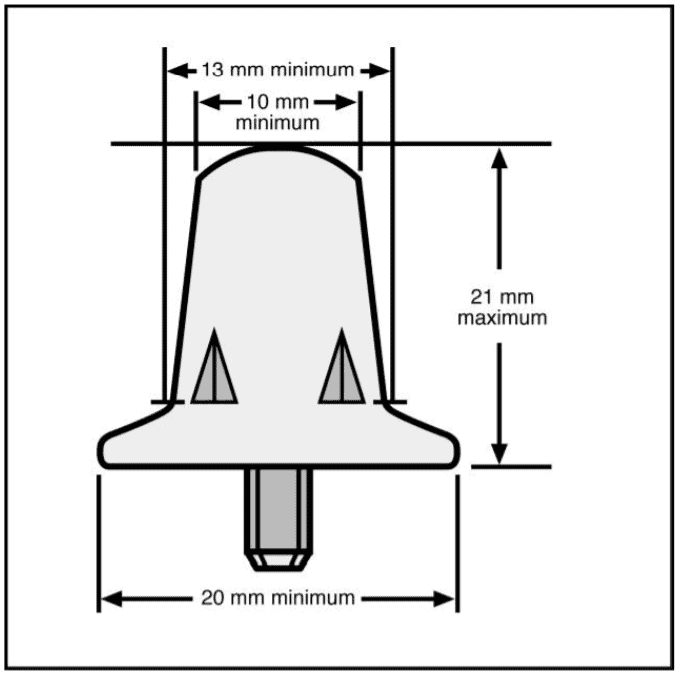Who’d be a referee hey? Not only do they have make the right calls all the way through the game, but even before the game starts they have to make sure that all players’ rugby boots adhere to the rules. So, what are the rules for rugby boots? Well, typically, World Rugby have left them somewhat open to interpretation. This is the rule pertaining to rugby boot studs:
Studs/cleats of player’s boots must conform with this World Rugby Specification (Regulation 12), they must not be longer than 21 mm, and must not have any burring or sharp edges.
The following diagram is offered by World Rugby as guide for stud size legalities. Note, how the stud needs to be rounded off at the top and not flat, and how the base of the stud needs to be 20mm. These two factors alone preclude quite a number of football type studs, more on that later.

You can download the full World Rugby specification guide here – fun it ain’t – yawn you will!
What boots are not allowed/illegal in rugby?
Boots that are not allowed in rugby are those which do not adhere to world rugby specifications article 12, so they must not have studs longer than 21 mm and those studs must not have any sharp edges or show any signs of burring (frayed edges).
Referees will check all studs before games to ensure there are no dangerous studs, or frayed blades, being worn. Referees are not looking for kite marks or for any particular brands of boot, just safety.
It is the players responsibility to ensure their boots are safe to play in. Personally, I prefer to buy boots directly from rugby specialist stores who are all producing boots that meet world rugby’s requirements.
My personal preference is for Gilbert. Their boots normally last me a couple of seasons and they have the right balance of sturdiness and agility. The current pick is this one which is fully compliant and very reasonably priced.
You might like: How To Choose Rugby Boots
Problems With Football Boots
Problems arise when players turn up to play with football boots. Often these are okay for playing in but the trend in recent years for football boots has moved away from ‘safe’ designs to designs which at times cross the line.
A lot of football boots will not have studs that are of the correct dimensions for rugby, in particular, they won’t be of the required width at the top of the stud. This makes them look more dangerous straight away, and, given the fact the rugby players’ boots are in and around the head of players on the floor are quite rightly deemed unsafe.
The good news is you can often simply replace the studs if they are of the screw on/off variety with a stud of the appropriate size.
The bad news is that not all boot manufacturers release studs out to retail stores and so you may have to track down your boot manufacturers compatible studs on their website in order to make the change – not ideal when you realise this situation on the morning of a game!
Secondly, football boots are often fitted with molded studs which is fine, however, molded studs have a habit of wearing down and developing sharp edges over time.
This time you do not have the option of simply changing the studs and are simply left to try and slice off any sharp edges with a knife, and who really wants to have to start hacking away at their expensive boots.
Thirdly, the shape of the blades on the sole of the boot can contain sharp edges even when brand new. Just lift up a few boots next time you are in a sports shop to see what I mean – zigzag patterns and other odd shapes make these boot types unsuitable for rugby.
21 mm studs in rugby: essential for driving through scrums, rucks and mauls
A quick word on the difference between rugby and football boots here is valid. Rugby boots are different in that they feature wider and more rigid soles, a raised heel, a greater number of studs (8 in rugby 6 in football boots) and often a higher ankle cut.
These features all add up to a a boot that is more supportive of the needs of rugby players and much more helpful in terms of injury prevention.
For those reasons as well as the fact that proper rugby boots will meet World Rugby’s safety guidelines I would certainly look for a boot made specifically for rugby, particularly if I was a forward in the scrum.
Consider reading: How To Wear In Rugby Boots (Avoid Blisters)
What boots are allowed/legal in rugby?
Boots that are allowed in rugby are those which are safe to play in as deemed by the referee during pregame checks. Boots that have any sharp edges or ‘burring’ (burring is when an edge becomes worn and frayed in appearance often creating sharp edges) will not be allowed. Whilst ‘blades’ are not banned in rugby they are more likely to burr and have sharp edges.
Apart from Gilbert, Canterbury are another fantastic specialist rugby brand and they produce some of the best boots on the market and have even supplied the All Blacks over the years. There current best seller is the Phoenix Raze pictured below which delivers in terms of comfort, lightweight and price!
Are blades allowed in rugby?
Blades are allowed in rugby provided they meet the minimum size requirements. However, It is not uncommon for rugby clubs to have a blanket ban on boots with blades. This is because although boots are checked for safety before games they are not checked for safety before training, therefore with a bladed boots tendency to develop sharp edges, it is just a safer policy to ban bladed boots.
Imagine collecting your son or daughter from rugby training only to find them with avoidable cuts or scratch marks on their body.
Or, imagine if you accidentally hurt someone with frayed blades slashing them down their legs whilst clearing out a ruck. It is just an unnecessary risk that a club can easily mitigate against by banning bladed boots.
If you are going to buy blades then the wisest move to do is to purchase them from a rugby brand, such as Gilbert, Canterbury, or the Adidas line of rugby boots. They will be fit for purpose and in line with requirements.
Even if you have bought blades from a reputable rugby manufacturer you need to avoid wearing your boots on hard ground, or concrete. This can lead to rapid deterioration and sharpening of boots edges.
Many players forget that even a short walk across a car park repeated at every training session and match can quickly lead to sharp edges that will need dealing with.
What boots do rugby players wear?
Rugby players generally wear rugby or football boots. Backs in particular may wear football boots due to their lighter weight and more contoured fit which aids in speed and agility. Forwards are more likely to be found wearing boots made specifically for rugby with 6 studs at the front and 2 studs at the rear.
Famously, Jonny Wilkinson and Steven Gerrard wore the Adidas Predator Pulse Special proving the crossover of football to rugby boots for backs at least.
Dan Carter also wore Adidas, wearing the Adidas Predator Incurza FG rugby boots for his last world cup winning final performance. So adidas seem to be a top favourite of professional rugby players in the backs at least.
These Kakari Light adidas boots, whilst being at the higher end of the price spectrum are the current preferred option for higher level players providing the stability required without compromising on fit, and weight therefore allowing backs to ‘do their stuff’ more easily.
On the other hand, in the forwards, Maro Itoje and Kyle Sinkler wear the made for rugby boot Adidas Kakari Z.0, or at least they did during the last world cup. Canterbury is the favoured boot supplier of Eben Etzebeth, the giant South African second row.
At lower levels of the game, where I have most of my experience, the issue of which boots to wear was often dictated by either the ego of the player wanting the newest flashiest design, or by necessity. Some of the big forwards simply would destroy those lightweight cheap football boots that some backs get away with.
Over the years, players figure out for themselves what meets their needs and tend to stick with what they know, for me that is Canterbury or Gilbert rugby boots. You might also like to read ‘What rugby players wear’ here too.
Finally, do remember that the referee is the sole judge of whether a boot is deemed safe for rugby or not. Just because a website says they are suitable for rugby does not mean that they will pass the refs test.
Remember boots can deteriorate from week to week. So, whilst one week they may be fit to play in the following week they may not be.
Suggested reading: How To Clean Rugby Boots?

